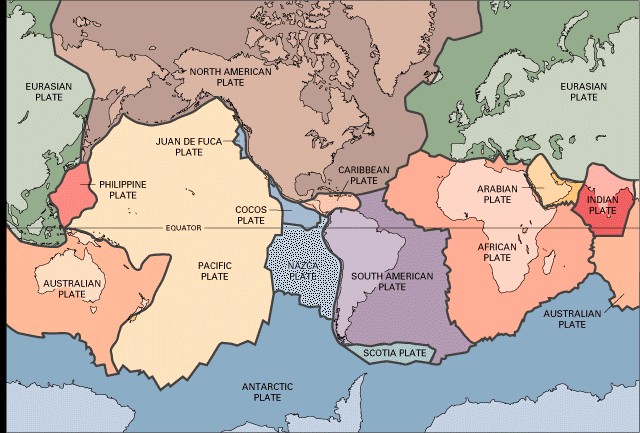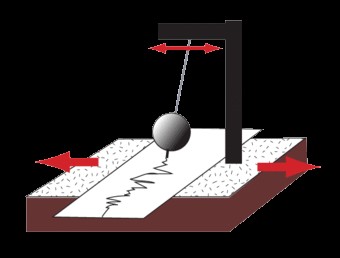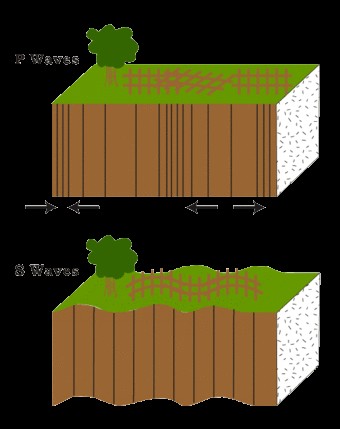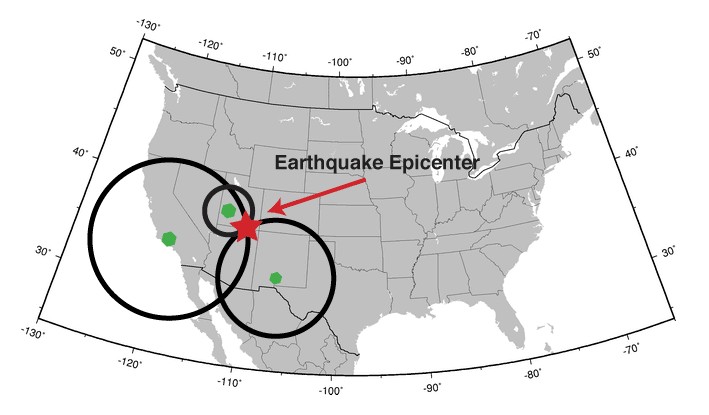What Is An Earthquake? Explore the science behind these natural phenomena with WHAT.EDU.VN. Understand the causes, measurement, and impact of seismic activity. Learn more about earth tremors and seismic events.
1. Defining Earthquakes: The Earth’s Sudden Shift
An earthquake occurs when two blocks of the earth’s crust abruptly slide past each other. The fault, or fault plane, is the surface where this slippage happens. The hypocenter, or focus, is the location beneath the Earth’s surface where the earthquake originates, and the epicenter is the point directly above it on the Earth’s surface. These events can have significant geological impact and are often studied in seismology.
Sometimes, smaller earthquakes called foreshocks precede a larger earthquake. However, scientists can only identify them as foreshocks after the main, larger earthquake occurs. The largest earthquake in a sequence is called the mainshock. Aftershocks, which are smaller earthquakes that follow the mainshock in the same area, always occur. Depending on the magnitude of the mainshock, aftershocks can last for weeks, months, or even years.
2. The Mechanics of Earthquakes: Causes and Locations
2.1 Earth’s Structure and Tectonic Plates
The Earth is composed of four major layers: the inner core, the outer core, the mantle, and the crust. The crust and the uppermost part of the mantle form a relatively thin outer layer.
This outer layer isn’t a single, continuous piece; instead, it’s made up of numerous pieces, similar to a puzzle covering the Earth’s surface. These pieces, known as tectonic plates, are constantly moving, sliding past each other, and colliding. The boundaries between these plates are called plate boundaries.
2.2 Plate Boundaries and Faults
Plate boundaries are composed of numerous faults, and most earthquakes occur along these faults. The edges of the plates are often rough, causing them to become stuck while the rest of the plate continues to move. Eventually, when the plate has moved far enough, the edges release along a fault, resulting in an earthquake.
2.3 Energy Release and Seismic Waves
When the edges of faults are locked and the rest of the plate is in motion, energy accumulates. When the force of the moving plates overcomes the friction of the fault’s jagged edges, the fault releases, and the stored energy is released in the form of seismic waves. These waves radiate outward from the fault in all directions, similar to ripples in a pond. As they travel through the Earth, seismic waves cause the ground to shake. When these waves reach the Earth’s surface, they shake the ground and everything on it, including buildings and people.
3. Recording Earthquakes: Seismographs and Seismograms
3.1 Seismographs: Instruments for Measuring Earthquakes
Seismographs are instruments used to record earthquakes. The recording produced by a seismograph is called a seismogram. A seismograph consists of a base that is firmly anchored to the ground and a heavy weight that is suspended freely. When an earthquake causes the ground to shake, the base of the seismograph also shakes, but the hanging weight remains stationary due to inertia. The difference in position between the shaking base and the motionless weight is recorded, providing a measure of the earthquake’s intensity.
3.2 Seismograms: Interpreting Earthquake Recordings
Scientists analyze seismograms to determine the size, location, and characteristics of earthquakes. The amplitude and frequency of the seismic waves recorded on a seismogram provide information about the earthquake’s magnitude and the distance to its epicenter.
4. Measuring Earthquake Size: Magnitude and Intensity
4.1 Earthquake Magnitude: Quantifying Earthquake Size
The magnitude of an earthquake is a measure of its size, related to the amount of energy released during the event. It is a single value for each earthquake. Scientists use seismogram recordings from seismographs to determine the magnitude of an earthquake. A short, low-amplitude line on a seismogram indicates a small earthquake, while a long, high-amplitude line indicates a large earthquake. The length of the wiggle is related to the size of the fault, and the amplitude of the wiggle is related to the amount of slip on the fault.
4.2 Earthquake Intensity: Measuring Ground Shaking
The intensity of shaking from an earthquake varies depending on the location. It is a measure of the effects of an earthquake at a specific location, such as the amount of ground shaking, damage to structures, and impact on people.
5. Locating Earthquakes: P-waves, S-waves, and Triangulation
5.1 P-waves and S-waves: Earthquake Messengers
Seismograms are also crucial for locating earthquakes. Identifying P-waves (primary waves) and S-waves (secondary waves) on a seismogram is essential. P-waves and S-waves are types of seismic waves that travel through the Earth at different speeds and with different characteristics. P-waves are compressional waves, meaning they cause particles to move back and forth in the same direction as the wave is traveling. S-waves are shear waves, meaning they cause particles to move back and forth perpendicular to the direction the wave is traveling.
5.2 Using P-wave and S-wave Arrival Times
P-waves are faster than S-waves, and this difference in speed allows scientists to determine the distance to an earthquake. By measuring the time difference between the arrival of the P-wave and the arrival of the S-wave on a seismogram, scientists can calculate how far away the earthquake occurred. This is similar to how we can estimate the distance to a lightning strike by measuring the time between seeing the lightning and hearing the thunder.
5.3 Triangulation: Pinpointing the Epicenter
While the time difference between P-waves and S-waves reveals the distance, it doesn’t specify the direction. Therefore, scientists use a technique called triangulation to pinpoint the precise location of an earthquake’s epicenter. Triangulation involves using data from at least three seismograph stations.
Each station records the arrival times of P-waves and S-waves, allowing scientists to calculate the distance from each station to the earthquake. These distances are then used to draw circles on a map, with each circle centered on a seismograph station and having a radius equal to the calculated distance to the earthquake. The point where the three circles intersect is the earthquake’s epicenter.
6. Earthquake Prediction: Current Limitations
6.1 The Elusive Goal of Earthquake Prediction
Despite ongoing research efforts, scientists are currently unable to predict earthquakes. While they can identify areas at high risk of earthquakes based on past seismic activity and tectonic plate movements, they cannot predict when an earthquake will occur.
6.2 Understanding Fault Behavior
Scientists understand that another earthquake will eventually occur on any particular fault, but they lack the ability to determine precisely when it will happen. The complex and unpredictable nature of fault behavior makes accurate earthquake prediction a significant challenge.
7. Earthquake Myths: Weather, Animals, and Human Sensitivity
7.1 The Myth of Earthquake Weather
The idea that weather conditions can influence earthquake occurrence is a common misconception. There is no scientific evidence to support a direct link between weather patterns and earthquakes.
7.2 Animal and Human Earthquake Sensitivity
Similarly, the belief that certain animals or people can sense impending earthquakes lacks scientific validation. While some anecdotal evidence suggests that animals may exhibit unusual behavior before earthquakes, these observations have not been consistently replicated or scientifically explained.
8. Frequently Asked Questions (FAQs) About Earthquakes
| Question | Answer |
|---|---|
| What is the most common cause of earthquakes? | The most common cause is the movement of tectonic plates. |
| How long can aftershocks last? | Aftershocks can last for weeks, months, or even years depending on the magnitude of the mainshock. |
| Can earthquakes occur in the middle of plates? | Yes, although they are less common than at plate boundaries. These are called intraplate earthquakes. |
| What is the Ring of Fire? | A major area in the basin of the Pacific Ocean where many earthquakes and volcanic eruptions occur. It is associated with a nearly continuous series of oceanic trenches, volcanic arcs, and volcanic belts and plate movements. |
| What is the deepest earthquake recorded? | According to the USGS, the deepest earthquake ever recorded occurred near Andreanof Islands, Aleutian Islands, Alaska, on 2013 August 12. The hypocenter depth was 735.8 km (457.2 miles). |
| How are tsunamis related to earthquakes? | Tsunamis are often caused by underwater earthquakes that displace large volumes of water. |
| Can human activities cause earthquakes? | Yes, certain human activities such as fracking, reservoir construction, and mining can induce earthquakes. These are referred to as induced seismicity. |
| What should I do during an earthquake? | Drop, cover, and hold on. Drop to the ground, take cover under a sturdy table or desk, and hold on until the shaking stops. If there is no shelter nearby, drop to the ground and protect your head and neck with your arms. |
| Are some regions more prone to earthquakes? | Yes, regions located near plate boundaries, such as California, Japan, and Chile, are more prone to earthquakes. |
| What are the effects of earthquakes? | Earthquakes can cause ground shaking, tsunamis, landslides, liquefaction, and structural damage to buildings and infrastructure. The severity of the effects depends on the magnitude of the earthquake, the distance from the epicenter, and the vulnerability of the affected area. |
| What is earthquake engineering? | Earthquake engineering is a branch of civil engineering that designs and analyzes structures, such as buildings and bridges, to withstand the effects of earthquakes. It involves incorporating seismic-resistant design principles and construction techniques to minimize damage and ensure the safety of occupants. |
| What are seismic gaps? | Seismic gaps are segments of active faults that have not experienced an earthquake in a long time. These areas are considered to be at high risk for future earthquakes, as stress continues to build up along the fault. Scientists monitor seismic gaps to assess the potential for future seismic activity. |
| How does the geology of an area affect earthquake damage? | The geology of an area can significantly influence the extent of earthquake damage. Soft soils, such as those found in river valleys and coastal areas, can amplify ground shaking and increase the risk of liquefaction. Areas with steep slopes are also more vulnerable to landslides and rockfalls during earthquakes. |
| How do scientists study past earthquakes? | Scientists study past earthquakes by examining historical records, analyzing geological evidence (such as fault lines and rock formations), and using paleoseismology techniques to determine the timing and magnitude of prehistoric earthquakes. This information helps them to understand earthquake patterns and assess future seismic hazards. |




9. Unveiling Earthquake Science with WHAT.EDU.VN
9.1 Your Gateway to Earthquake Knowledge
Understanding earthquakes involves delving into complex scientific principles, but it doesn’t have to be difficult. WHAT.EDU.VN provides comprehensive explanations, clear definitions, and up-to-date information about these fascinating natural phenomena.
9.2 Ask Your Earthquake Questions Freely
Do you have questions about earthquakes that haven’t been answered here? Are you curious about specific earthquake events, the science behind them, or the latest research in seismology? Visit WHAT.EDU.VN to ask your questions and receive informative answers from our team of experts.
9.3 Connect with Us
For more information or assistance, contact us at:
- Address: 888 Question City Plaza, Seattle, WA 98101, United States
- WhatsApp: +1 (206) 555-7890
- Website: WHAT.EDU.VN
At what.edu.vn, we’re dedicated to providing you with the knowledge and resources you need to understand the world around you. Don’t hesitate to reach out and explore the world of earthquakes with us. We make science accessible to everyone. Understanding geological hazards is easier than ever with the resources at hand.

